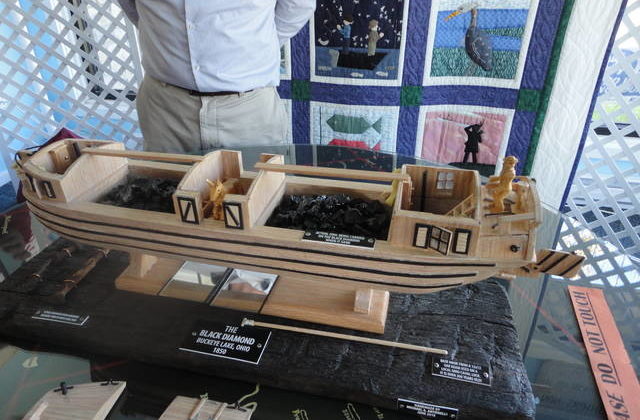
Ohio’s past surfaces at Buckeye Lake
Story and photo by Jane Beathard

She is a piece of Ohio history that hasn’t been seen since 1850.
The Black Diamond canal boat — or what was left of her — rested at the bottom of Buckeye Lake for 166 years until a drawdown of the lake in recent years revealed her soggy skeleton.
Construction of a new dam at the lake made the drawdown necessary.
Shipwrecks are a common find in Lake Erie, but few are found in inland lakes, according to Justin Zink, project leader with Lawhon & Associates, the environmental consulting firm involved in the dam construction.
“This is the first archaeological documented canal boat (find) in Ohio,” said Andy Sewell, a historian with Lawhon.
Prior to the coming of the railroads, canal boats were the best way to get around in Ohio. Between 1830 and 1870, the Miami-Erie Canal in western Ohio and the Ohio-Erie Canal on the east, along with a network of spur canals, moved people and goods between the Great Lakes and the Ohio River. They were drawn by horses or mules and were sometimes “poled” by crew members through the shallow canals.
Buckeye Lake was one of many “feeder” reservoirs that supplied water for the 813-mile Ohio-Erie Canal that ran between Cleveland and Portsmouth.
Traffic peaked on the canal in 1851. By 1877, railroads had largely put all Ohio canals out of business, Sewell said.
Boats on the canals were built for specific purposes. Some, like the Black Diamond, were freighters — designed to haul cargo. Others were more comfortable passenger boats.
The Cleveland-owned Black Diamond was built in Akron in 1845. She was captained by a man named Ward who lived in Newark.
She was possibly carrying as much as 80 tons of coal to a grist mill at Thornport — a village on Buckeye Lake — when she strayed out of the channel, struck a tree stump and started to sink. The crew pushed her toward the north shore and tried desperately to salvage what they could of her cargo before she went down, said J-me Braig, director of the Museum at Buckeye Lake.
It was an important task because in early Ohio, coal was so valuable that it was like “diamonds,” Sewell noted.
Braig said long-time area residents knew the Black Diamond was there. Its sinking is noted in “The Story of Buckeye Lake” by Joseph Simpson. But no one knew exactly where the wreckage lay or what condition it was in.
All that changed on Feb. 20, 2016, when the first water-logged timbers were spotted, poking through the muck.
Over the next few months, Zink and others salvaged 388 individual wooden timbers, mostly keel and floor pieces of the boat. They also recovered dozens of iron nails, 301 household artifacts and 402 pounds of coal from the wreck site.
After consulting with experts from the Ohio DNR, Ohio History Connection and others, Lawhon staff cleaned, measured and photographed the pieces. All but three were eventually re-submerged in the lake so they would not degrade further.
The three saved timbers went to a lab in Maryland that specializes in preserving water-soaked wood. In about three years, they will go on display in the Buckeye Lake museum along with additional information about Ohio’s historic canals, Zink said.
In addition, a Heritage Trail planned for the top of the new dam will note the Black Diamond’s original location and history.
Most significantly, an authentic replica of the Black Diamond was commissioned for display in the museum.
Model shipbuilder Michael Antonelli, a native of the lake area, researched the history of coal-carrying canal boats and how they were constructed. He made sure each painstaking detail of the model would be authentic and accurate, Zink noted.
“It was a labor of love for him,” he said.
That 26-inch model was unveiled during a special ceremony at the museum in September. It is made to scale and holds a miniature cargo of the actual coal that was salvaged from the Black Diamond. It has working hatches, ropes and cabin furniture, as well as a tiny captain and an equine passenger.
Braig valued the model at $10,000.
____
The Museum at Buckeye Lake
4729 Walnut Road, Buckeye Lake.
1-4 p.m. Tuesday-Sunday
ID, 'source', true); $sourcelink = get_post_meta($post->ID, 'sourcelink', true); $sourcestring = '' . __('SOURCE','gabfire') . ''; if ($sourcelink != '') { echo "
$sourcestring: $source
"; } elseif ($source != '') { echo "$sourcestring: $source
"; } // Display pagination $args = array( 'before' => '' . __('Pages:','gabfire'), 'after' => '
', 'link_before' => '', 'link_after' => '', 'next_or_number' => 'number', 'nextpagelink' => __('Next page', 'gabfire'), 'previouspagelink' => __('Previous page', 'gabfire'), 'pagelink' => '%', 'echo' => 1 ); wp_link_pages($args); // Display edit post link to site admin edit_post_link(__('Edit','gabfire'),'','
'); // Post Widget gab_dynamic_sidebar('PostWidget'); ?>